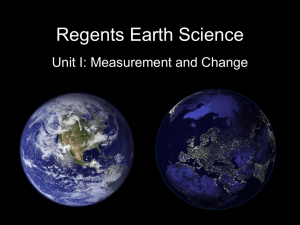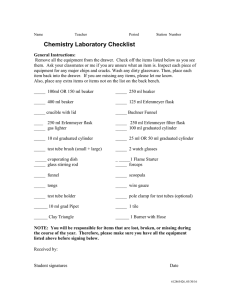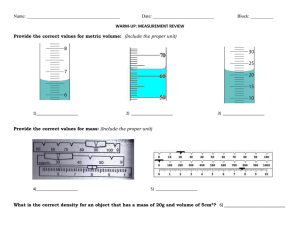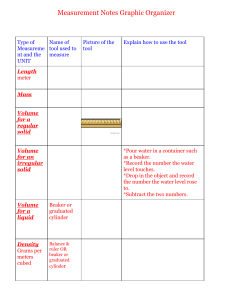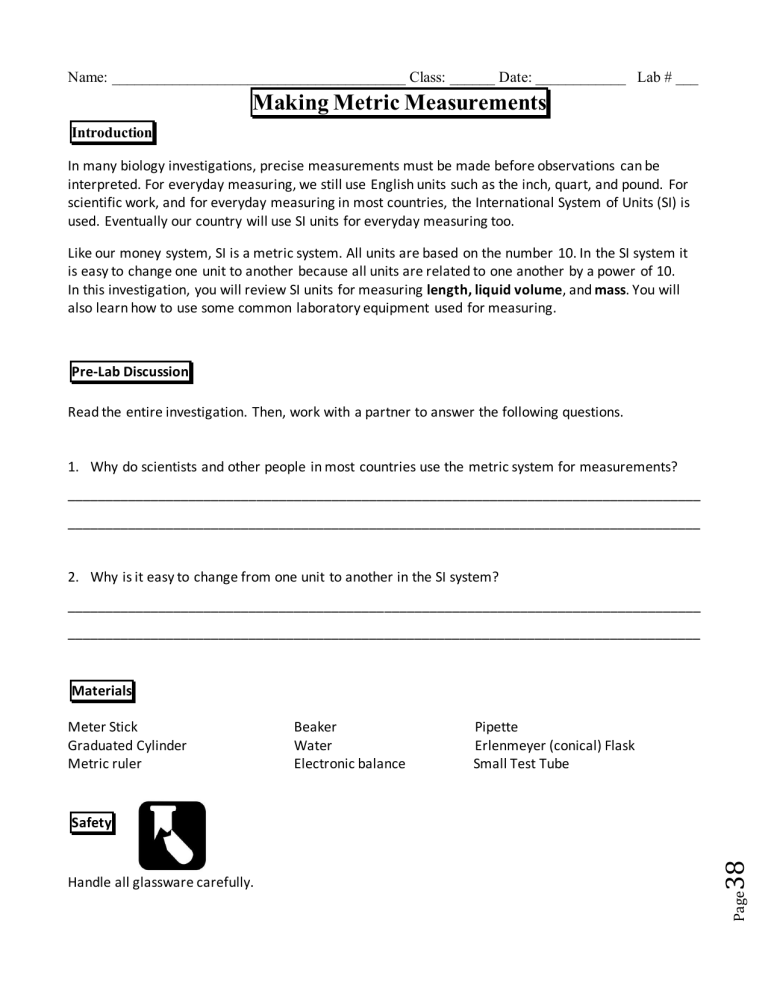
Name: _______________________________________ Class: ______ Date: ____________ Lab # ___ Making Metric Measurements Introduction In many biology investigations, precise measurements must be made before observations can be interpreted. For everyday measuring, we still use English units such as the inch, quart, and pound. For scientific work, and for everyday measuring in most countries, the International System of Units (SI) is used. Eventually our country will use SI units for everyday measuring too. Like our money system, SI is a metric system. All units are based on the number 10. In the SI system it is easy to change one unit to another because all units are related to one another by a power of 10. In this investigation, you will review SI units for measuring length, liquid volume, and mass. You will also learn how to use some common laboratory equipment used for measuring. Pre-Lab Discussion Read the entire investigation. Then, work with a partner to answer the following questions. 1. Why do scientists and other people in most countries use the metric system for measurements? ____________________________________________________________________________________ ____________________________________________________________________________________ 2. Why is it easy to change from one unit to another in the SI system? ____________________________________________________________________________________ ____________________________________________________________________________________ Materials Meter Stick Graduated Cylinder Metric ruler Beaker Water Electronic balance Pipette Erlenmeyer (conical) Flask Small Test Tube Page Handle all glassware carefully. 38 Safety Procedure Part A. Measuring Length 1. Obtain one of the small plastic rulers. Notice that the ruler has metric units on one edge and English units (inches) on the other edge. On the metric edge, the numbered lines are centimeters (cm) and the small unnumbered lines are millimeters (mm). a) According to your ruler, how many millimeters are there in one centimeter? ________ mm b) According to your ruler, how many centimeters are on the ruler? ________ cm c) According to your ruler, how many millimeters are on the ruler? _________ mm Now complete the following 1 cm = _________________ mm 15 cm = _________________ mm 2. Obtain a meter stick. Notice the meter stick has units on both sides of it. One side has the metric units and the other has the English units (inches). On the metric side, the numbered lines are centimeters (cm) and the smaller unnumbered lines are millimeters (mm). a) According to your meter stick, how many millimeters are there in one centimeter? ______ mm b) According to your meter stick, how many centimeters are on the meter stick? ________ cm = __________ cm 100 mm = __________ cm 100 cm = __________ m (meter) Page 10 mm 39 Now complete this 3. Use the meter stick to measure the length, width, and height of your laboratory table or desk in meters. Record your measurements to the nearest hundredth of a meter in Data Table 1. 4. Convert (change) the measurements from meters to centimeters and then to millimeters. Record these measurements in Data Table 1 Data Table 1 Lab Table Measurements Dimension m cm mm Length Width Height 5. Use a metric ruler to measure the length of a small test tube and the diameter of its mouth in Centimeters. Record your measurements to the nearest millimeter in Data Table 2. 6. Convert (change) the measurements from centimeters to millimeters. Record these measurements in Data Table 2. Data Table 2 Test Tube Measurements Dimension m cm mm Length Diameter of Mouth Part B. Measuring the Volume of a Liquid This curved surface is called a meniscus. To measure Page 2. The surface of the liquid will be slightly curved. 40 1. Fill the test tube to the top with water. Pour the water into the graduated cylinder. the volume accurately, your eye must be at the same level as the bottom of the meniscus (see Figure 1) Record the volume of the water from the test tube to the nearest milliliter in Data Table 3 below. Data Table 3 Measurement of Volume Object Volume (mL) Water in Test Tube 3. Find the amount of liquid (to the nearest milliliter) in each of the graduated cylinder sections 1 – 4 shown below ____________ _____________ _____________ ____________ Part C. Measuring Mass Page Problem: 41 1. How much do you think is the mass of 50 mL of water? ________________ g (Note: there is no right or wrong answer here. This is just your prediction! Take a guess) You are provided with three laboratory containers, an Erlenmeyer (conical) flask, a beaker, and a graduated cylinder. Which container (Erlenmeyer flask, a beaker, or graduated cylinder) do you think will be the most accurate for measuring 50 mL of water? Why? _________________________________________________________________________________ _________________________________________________________________________________ To find out whether or not your prediction is correct, do the following 2. Be sure that the number on the screen of the balance is at 0.00 g (see Figure below) 3. Place the beaker on the pan of the balance and record its mass (dry mass) in Data Table 4. 4. Now pour some water into the beaker to the 50 mL mark, and then find the mass of the beaker with water. Record this mass in Data Table 4. 5. Repeat steps 2 through 4 for the graduated cylinder and the Erlenmeyer (conical) flask. Page 42 6. Find out the mass of water and fill in the column for the mass of water for each container. Data Table 4 Dry mass of container (g) Mass of container filled to 50 mL water (g) Mass of water only (g) Beaker Erlenmeyer(conical)Flask Graduated Cylinder 7. Based on your results in Data Table 4, which container is the most accurate for measuring 50 mL of water? Was your prediction supported by your results? Explain. ________________________________________________________________________________ ________________________________________________________________________________ ________________________________________________________________________________ 8. Based on your results in Data Table 4, how much is the mass of 50 mL of water? ____________ g Was your prediction supported by your result? Explain. ______________________________________________________________________________ ______________________________________________________________________________ ______________________________________________________________________________ Your results most likely contain some measurement error. The estimated mass of 50 mL of water in each container is probably just above or below the ideal mass. See if you can figure it out. Page 43 Ideally, without measurement error, 50 mL of water will always be ___________ grams of water. Analysis and Conclusions 1. Calculating: How do you convert (change) a) Meters to centimeters? _____________________________________________________________________________ b) Centimeters to millimeters? _____________________________________________________________________________ 2. Observing: What is the largest volume of liquid your graduated cylinder can measure? _________ 3. Observing: What is the smallest volume of a liquid your graduated cylinder can measure? ______ 4. Calculating: Based on the measurements you did and recorded in Data Tale 4 above; what is the mass of 50 mL of water? ___________________________________________________________ Explain your answer: _____________________________________________________________ ________________________________________________________________________________ 5. Predicting: How would you find the mass of a certain amount of water that you poured into a paper cup? _______________________________________________________________________ _________________________________________________________________________________ _________________________________________________________________________________ _________________________________________________________________________________ 6. Calculating: In this investigation you found the mass of 50 mL of water. Based on your Page 44 observations, what is the mass of 1 mL of water? __________________________________
